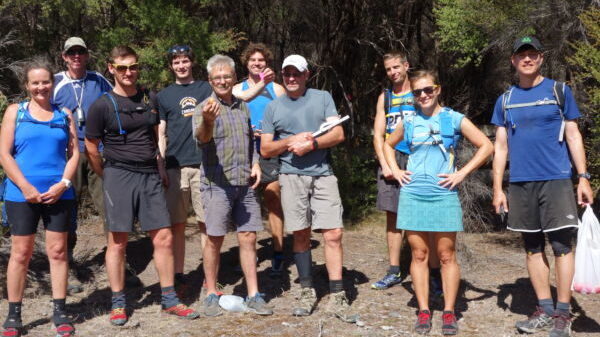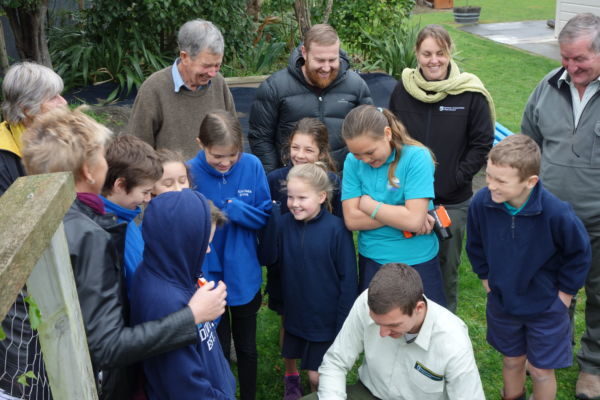Many years ago, Clive Paton’s aunt, Noeline Paton, used to run Forest & Bird in Otago. She was an early influence in his life.

“She used to send me Forest & Bird magazines when I was young,” Clive recalls, “She sent them even when I was in my early 20s. It always stuck with me that maybe she had a sense that I might do something in the future.”
Aunt Noeline wasn’t wrong.
Nowadays Clive is a well-known grape grower in southern Wairarapa. Back in 2002, he bought a 300 acre block of land in the Waihora catchment, about 10 minutes south of Martinborough. Of that, 50 acres was prime land for grape-growing and another 150 acres was placed under DOC covenant. Bush Block borders the Aorangi Forest Park.

“I needed somewhere to plant trees,” says Clive, who is also involved in ‘Project Crimson’, “Then over the next few years I got to know the forest park behind. It needed looking after. DOC were caretakers, but there was no major predator control going on. Then, when I discovered a stand of rata, I started propagating it.”
It was just the beginning.
The Greater Wellington Regional Council did a survey of about 8000 areas of privately owned bush. Bush Block ranked about 11th on their list.
“I was keen to do predator control,” says Clive. “Then, after a few years I felt the whole Aorangi range needed looking after. So I mobilised people. We called a meeting in Martinborough and 90 hunters turned up!”
Aorangi Forest Park is designated a recreational hunting area.
“We needed to get hunters on-side,” says Clive. “We could see that we could do a lot of work even with deer and pigs in there. If we tried to eliminate them, we wouldn’t have got past first base. The Aorangi Restoration Trust is one of the few ecological restoration projects in New Zealand to have the deerstalkers on-side.”
Paul Cutfield, whose land is on the south eastern boundary of the Aorangi Forest, 50km away from Martinborough, is a farmer, hunter and conservationist and key member of the Aorangi Restoration Trust. He looks after the needs, concerns and interests of the deerstalkers. That was pivotal when it came to getting agreement for an aerial 1080 drop in southern parts of the park, where possum numbers were high, back in 2006. In 2009, a further drop of 1080 with deer repellent occurred in the northern parts of the park.
“When the Aorangi Restoration Trust was formed in 2011, OSPRI were contemplating further 3-yearly 1080 drops,” says Clive. “We again convinced the deerstalkers that it could be done with deer repellent.”
The subsequent 1080 drop in 2014 was a large-scale demonstration for the use of deer-repellent in 1080 baits, being done over a total area of 33,000 ha, comprised of 20,000 ha of forest park and another 13,000 ha of surrounding regenerating forest where the private owners were happy to have 1080 applied.
“Deer numbers haven’t decreased in 14 years in my area,” says Clive. “The population is in a steady state. One research project we’d like to do is monitoring the deer population to see what is happening with deer numbers and the condition of the forest. Currently it’s anecdotal.”
If funding is available, the monitoring project would probably be done through Victoria University of Wellington, whose researchers have been involved in several other studies in the Aorangi Forest since the Trust’s formation. The Trust and University work closely together.
Bob Burgess – project manager for the Aorangi Restoration Trust – is a retired scientist. He trained in plant ecology and recently worked at Victoria University. In his project manager role he continues to work closely with the University’s scientists.
“Vic Uni is carrying out a significant 10-year monitoring project with TBfree NZ (OSPRI) funding,” says Bob. “They’re monitoring the impacts of 1080 as part of three scheduled drops – 2014, 2017 and 2020 – monitoring vegetation, birds, insects and predator levels, comparing Aorangi with Rimutaka which has a different 1080 schedule of control.”
The scientists are already getting some interesting results…
A frequent claim of aerial 1080 opponents is that “the forest goes silent after a 1080 drop…”
‘Not so’, according to a 2014 study which recorded birdsong before and after the 1080 drop that year.
“The birdsong actually got louder immediately after the drop across all native species,” says Bob.
That result was obtained from 3000 hours of acoustic recordings, made at various times of day and night, by 24 automated sound recording devices which were on location for several months before and after the 1080 drop.
Other Victoria University research projects have looked at the relationships between the forest, seed masting and the effectiveness of 1080 in reducing rat numbers.
“Rat numbers went down immediately,” says Bob, “but the rats were back to pre-1080 levels within 6 months. Possums too recovered, but at a much slower rate. It took about 2 years for possum numbers to get back to pre-1080 levels.”
The scientific research has practical implications for pest control in the park.
“Pest control needs to be responsive, triggered by the results of monitoring pest and bird numbers. And timing of 1080 drops,” says Bob, “needs to be in early spring, so there will be low rat levels when the birds are breeding.”
Birds will then have a rat-reduced ‘window of opportunity’ in the critical period when eggs, nestlings and incubating adults are vulnerable to predation.
But 1080 is only one tool in the arsenal of pest control at Aorangi. The Restoration Trust wants to encircle the park with a predator control buffer to reduce predator levels and limit reinvasion of the 1080 zone. Currently, there are 30 traplines around a perimeter of about 150km. They’re checked regularly by over 100 volunteers. Some of those volunteers come from as far away as Marton in the Rangitikei, Wellington and Palmerston North to service their trapline monthly.
“Many farmers monitor traps on their own land or allow volunteers on their farms,” says Bob. “The volunteers include walkers, trampers and even runners. The Aorangi Undulator runners compete in an annual 33km trail running race taking them through five valleys and four undulations of the Aorangi mountains. There’s also a 3-day 100km event. They raise funds and generously sponsor the Trust – and also regularly service one of the traplines.”
Education is another key activity of the Trust.
“It’s securing our future,” says Bob. “We contacted two local primary schools soon after the Trust was set up and the children helped make penguin boxes and set them out.”
The Aorangi restoration area includes a coastal boundary where little blue penguins nest. The penguins are not, however, as abundant in the area as they once were and the Trust hopes to encourage them back to the south Wairarapa coast. It is an ideal project to involve the school children in.
“More recently, in August 2016, with funding from the Fonterra Community Fund, we bought twenty self-resetting traps which were given to the two schools,” Bob says. “It’s fantastic to see the kids’ enthusiasm – learning about safety and working with traps and also learning about ‘why’.”
Clive Paton agrees.
“Now we need to take the next step,” he says. “We need to take the really interested kids trapping on the coast and in the bush so that they become capable of doing their own trapping. They are the future – and guardians of the area. We need to ensure that the next generation has better knowledge.”
Education was, after all, how his own interest in conservation was sparked – through the efforts long-ago of Otago Forest & Bird stalwart, Aunt Noeline.

